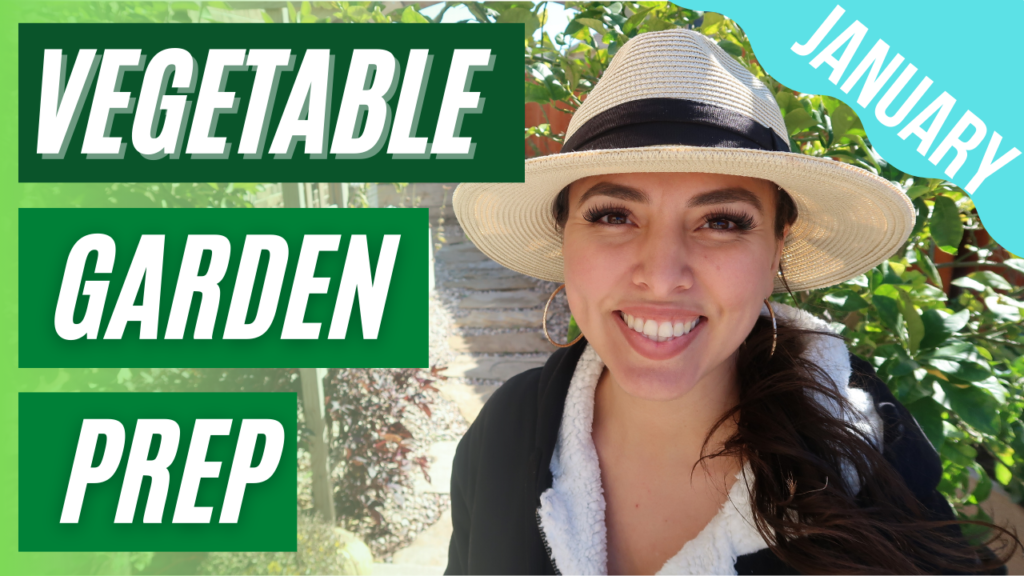What to do in JANUARY for your Vegetable Garden
Are you thinking about starting a Vegetable Garden? I’m creating a new series that will help you with your vegetable garden. At the beginning of each month, I’ll post a video on this series so you can have a successful gardening year and an abundance of food.
I live in South Texas, zone 9a, so this will be applied based on your months temperatures. January average temperature here is 35-65F.
I’ve separated the tasks by 3 Categories:
CATEGORY #1 - Things TO DO
- This is the time to build your raised beds. In 2020, there was lumber shortages due to the high rise of home building. Lumber was more expensive. Keep in mind: you don’t have to make raised beds like mine – you only need to raise the ground level 6-12″.
- Anything that involves intensive labor – you want cooler weather.
- If you have temps in the 50s, this is perfect weather.
- You want to have your beds ready for Spring
- I’m giving you plenty of time to get them ready!
- You want to have time for your soil to settle
- Fill to brim and wait for a heavy rain day to review how much more soil you need. Leave 2″ from the brim so water doesn’t spill over.
- Anything that involves intensive labor – you want cooler weather.
- Start your composting – this will give you a few months to have compost ready *you have material from fall*
- Rake all the dry leaves
- Make sure ground hasn’t been treated with toxic fertilizers
- Winter Pruning
- I’ve pruned my backyard orchard – check it out here.
- Product from cleaning the vegetable beds
- Retired plants
- Purchase a Worm Farm (little space and fast producing)
- You have to be ‘OK’ with Red Wigglers. It takes a little time to adjust but it is SO worth it. I’ve purchased mine – check out the video here.
- Start collecting food scraps.
- Freeze them or leave a container in the fridge for them.
- Rake all the dry leaves
- If you have seeds, read the back of your seeds and separate them by:
- Season – check out book ‘Kitchen Garden Revival‘ that has good information on seasonal harvest.
- Sowing
- Indoor/Outdoor
- Indoor – When to transplant
- Example 3-4 wks, 6-8 weeks, etc.
- Outdoor – make sure they are Frost Tolerant
- Indoor – When to transplant
- Indoor/Outdoor
- Create Labels
- Tedious task – stay ahead of them
- Take Inventory
CATEGORY #2 - WHAT TO PURCHASE
- Seeds (buy local)
- Soil amendments *if your climate allows you to sow in January* – The sooner you can start on the soil the better because it takes time to build the best soil.
- Compost
- Castings/Manure
- I have purchased Worm Castings and Rabbit manure (first time trying)
- Gardening Pots
- For inexpensive, first time gardeners, I would recommend bags with handles.
- Indoor Light System and Supplies. CaliKim has a great book on this.
- Seed Starting Mix
- Trays / Cups / Recycled containers
- Structures (split cost between 3 months)
- Arches or Supplies for DIY
- Obelisks
- Cages
- Trellis
- Fruit Trees
- Buy Local
- Order Dormant Trees online
- Jan/Feb only (sooner if you have early freezing temperatures)
CATEGORY #3 - IN THE GARDEN
Direct Sow (60 days):
~~~Check the weather and make sure there isn’t a high chance of rain~~~
~~~Plant densely – you run the risk of mold and mildew during this time~~~
- Root Crops
- Carrots
- Radish (Germinates @38F)
- Beets (1-2 wks to germinate)
- Herbs
- Celery (Germinates @40F)
- Fennel
- Parsley
- Cilantro
- Dill
- Peas
- Lettuce (can grow through May)
- Swiss Chard
- Spinach (2-4wks to germinate)
- Kale
Indoor Seeds:
- Tomatoes
- Peppers
- Lavender
- Celery
- Eggplant
- Onions
- Snapdragons
Starts:
- Brassicas
- Broccoli
- Cauliflower
- Brussel Sprouts
- Cabbage
- Strawberries
Play Video

